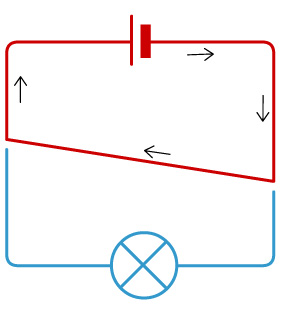- Electricity
What is a short circuit?

A simple, well-designed circuit, as discussed earlier, has a cell providing current along a path (wire) to a load (resistor) and back to the other end of the cell, as shown in this diagram.
As the voltage gets to the resistor (load), there is a power drop. The drop in power is because the resistor uses some of the electricity to produce heat and light. The result is, the voltage that ends up at the other side of the cell is reduced.
In a short circuit, there is no load. For many reasons, the wires in a circuit can find a short-cut, bypassing the load (and other components). Such a connection causes the same voltage from the cell to flow to the other end of the cell. When this happens, the high voltage causes the wires to heat up and catch fire.
In the diagram below, notice that the arrows show the direction of current flow. Notice how the current makes a short-cut, bypassing the other components of the circuit.
Can you think of some reasons why there could be a short circuit?
Here are a few:
- Wires may lose their insulation and touch each other in the circuit.
- There could be a fault (improper wiring) in a device.
- Intentionally connecting both ends of a cell/battery with wires.
This connection causes a massive drain of electricity, and the battery loses its power in a short time.
A short circuit can cause heating, melting of wires, harmful smoke and smell, and blinding light (like what you see during welding)
